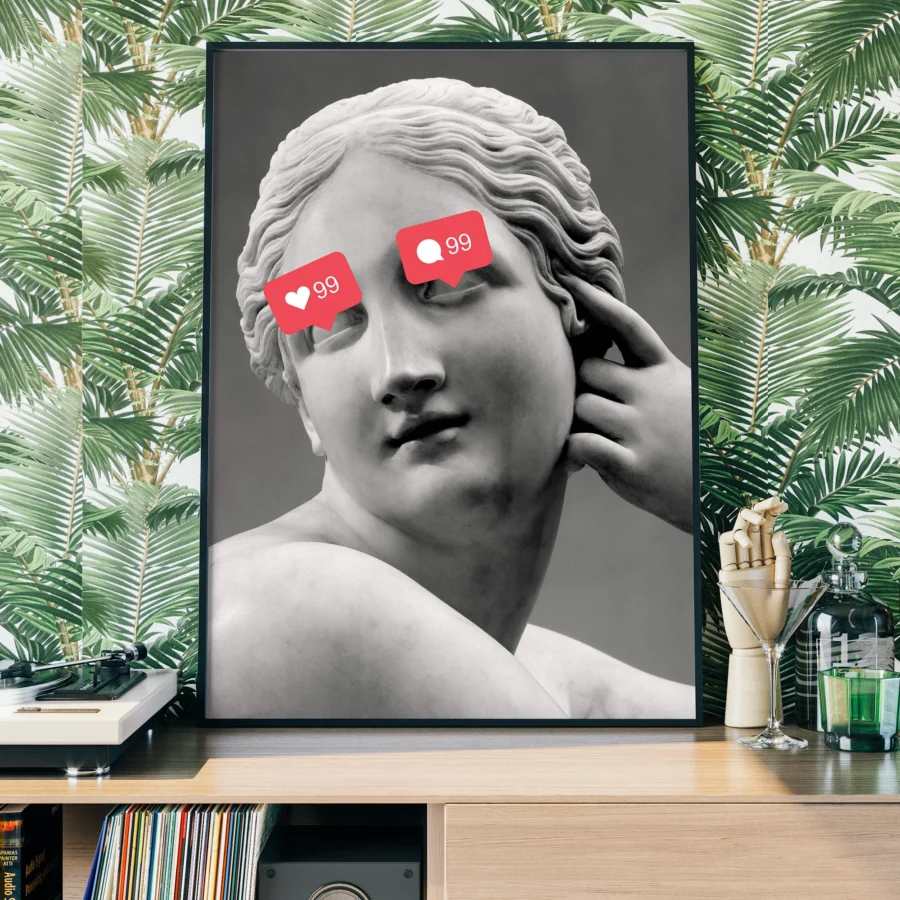The digital landscape has become an essential stage for artists by July 2025, offering global reach, direct audience interaction, brand identity building, promotion of art and music discovery, and diverse monetization avenues. For artists, a strategic multi-platform approach is crucial to remain relevant, cultivate connections, and effectively promote their work in this evolving digital space.
A central trend in 2025 is the increasing importance of authenticity over perfection. Sharing behind-the-scenes insights, unfinished works, or personal moments humanizes the artistic presence and creates a deeper level of trust and loyalty with the audience. This marks a clear departure from the exclusive presentation of perfectly curated, flawless images. A robust online presence, comprising a professional website as its core and consistent branding across all social platforms, is crucial for establishing credibility and increasing sales. While social media enables quick interaction, one’s own website continues to serve as a digital “home base” to comprehensively present the portfolio and gain valuable email subscribers.

The Democratization of the Art World
The digital transformation has fundamentally democratized the art world and created a direct-to-fan (D2F) economy for artists. The repeated emphasis on “global reach,” “direct fan interaction,” and “monetization opportunities” in current analyses underscores that social media can bypass traditional “gatekeepers” like galleries or labels that once controlled access and dissemination of art. The ability to “own” one’s fan base through email lists and personal websites further reinforces this development. A single viral post can turn an unknown artist into an overnight sensation, illustrating the far-reaching impact of this democratization. This development means that artists gain greater autonomy over their careers, as they can build direct relationships with their audience, control their own narrative, and monetize their works without the need for intermediaries. This can lead to increased financial stability and expanded creative freedom, as dependence on traditional industry structures decreases.
The Authenticity Paradox: Curated Genuineness
At the same time, a fascinating “authenticity paradox” is emerging in digital marketing. While the urgent recommendation is to be “authentic rather than perfect” and to “stay real,” effective social media management requires highly strategic planning, often involving the use of AI tools and meticulous content optimization. The challenge lies in conveying an impression of effortlessness and genuineness despite this calculated approach. Artists must master the art of curated authenticity. This means consciously revealing aspects of their vulnerability, creative process, and personal stories, while simultaneously maintaining a professional and consistent brand image. The trend towards “unhinged content” on platforms like X suggests that calculated imperfection can be a powerful tool for increasing engagement. However, this requires a deep understanding of one’s audience and the boundaries of one’s own brand to avoid appearing unprofessional.
The Most Important Platforms and Their Strengths
An artist’s digital presence in 2025 requires a differentiated approach to each social media platform, as each has its own strengths, target audiences, and algorithmic peculiarities. An effective multi-platform approach does not mean posting the same content everywhere, but rather adapting content to the specific requirements and expectations of each platform.
- Instagram: Instagram remains a primary platform for visual artists and photographers, ideally suited for presenting a cohesive aesthetic and personal brand. It functions as an online gallery where artists can control the first visual experience for potential viewers. Content such as Reels for performances, carousels for detailed insights, and Stories for interactive Q&As are particularly effective. The algorithm favors authentic interactions, interest-based content, timeliness, and consistency. New in 2025 are scheduled DMs, the ability to save songs directly to Spotify, and adding a song to the profile, simplifying cross-promotion.
- TikTok: TikTok is a powerhouse for music discovery and cultural acceleration, where creativity goes viral and the algorithm loves experimentation. Audience size is less critical for discoverability, giving new artists a fair chance. Popular content includes behind-the-scenes insights, storytime videos, skits, memes, challenges, POVs, and duets. Strategic use of trending audios and hashtags is crucial. The TikTok algorithm prioritizes engagement (especially watch time, shares, and saves), originality, and video completion rate. Videos longer than 30 seconds are increasingly preferred. The “TikTok for Artists” platform offers special analytics, pre-release tools, and a Music Tab.
- YouTube: YouTube is the go-to for long-form content and in-depth storytelling, crucial for building deep connections and loyal fan bases. It’s ideal for musicians, visual artists, performers, and multidisciplinary creatives. Content ranges from highly produced music videos to YouTube Shorts and live streams. YouTube Shorts should be a high priority for discovery. The algorithm rewards consistency, high-quality content, viewer satisfaction, and high audience retention. The concept of EEAT (Experience, Expertise, Authoritativeness, Trustworthiness) is gaining importance.
- Threads: Threads is characterized by its casual, conversational nature, thriving on unfiltered updates and direct fan interaction. It’s valuable for all artists to share thoughts, illuminate creative processes, and offer exclusive content. Content can include short thoughts, questions, longer posts, exclusive snippets, and Q&As. Images and videos tend to perform better than pure text. The Threads algorithm prioritizes conversation and rewards specificity and consistent posting. New features in July 2025 include direct messages and highlighted perspectives.
- LinkedIn: LinkedIn is the professional networking platform par excellence, ideal for artists connecting with galleries, collectors, industry experts, and potential business clients. It’s particularly suitable for visual artists, photographers (B2B), and multidisciplinary creatives for career development. Content should include a professional portfolio, project milestones, exhibition announcements, and thoughtful contributions. Optimizing the profile, soliciting recommendations, actively participating in groups, and personalizing connection requests are key strategies.
- Pinterest: Pinterest functions as a visual search engine and source of inspiration, excellent for driving traffic to external websites. It’s frequently used for planning future projects and ideas. It offers unique opportunities for visual artists, photographers, multidisciplinary creatives, and musicians. Content should be visually appealing, have optimized Pin dimensions, and include educational infographics, mood boards, or lyric art.
- X (formerly Twitter): X is a platform for real-time conversations and quick updates, excellent for staying in the moment and making cultural commentary. It’s a good place to discover new things. Content can include live reactions, humor and memes, teasers, discussions, and short updates. Using relevant hashtags and participating in trending topics is crucial. The algorithm prioritizes timeliness, relevance, diversity, media files, engagement, and account credibility.

Other Platforms
In addition to the main players, niche platforms and specialized services also offer valuable opportunities:
- Discord: Ideal for building loyal, exclusive, and fan-driven communities, enabling direct interaction and private community spaces.
- Patreon: Offers superfans intimate access and long-form content, allowing artists to monetize through tiered memberships and exclusive content.
- Twitch: A platform for real-time connections and interactive live content that fosters parasocial relationships.
- Tumblr: Can serve as a creative diary emphasizing nostalgia and personal storytelling.
- BlueSky: An emerging platform offering niche conversations and intimate creative exchange for early adopters.
The Hub-and-Spoke Model for Strategic Presence
The digital ecosystem for artists requires a strategic balance between platform specialization and cross-promotion. While a “multi-platform approach” is often emphasized, it’s also advisable to “choose channels wisely” and “focus on 1-2 platforms” to avoid overstretching. This apparent discrepancy can be resolved by applying a hub-and-spoke model. One’s own website serves as the central “hub” where all primary information such as portfolio, shop, Electronic Press Kit (EPK), and contact information are bundled. The various social media platforms then function as “spokes,” whose main purpose is to drive traffic back to this hub. It is crucial to create platform-native content that is tailored to the specific strengths and audience expectations of each platform. The strategy is not to replicate content everywhere, but to adapt it and then strategically link back to the central source. For example, a TikTok Reel could tease a new song, with a call-to-action (CTA) to listen to the full track on Spotify (linked in the bio), from where it links to the artist’s website for merchandise. Artists must evolve into “algorithmic strategists,” understanding not only what to post, but also how the underlying mechanisms of the platform favor or suppress that content.
Content is Queen: What Really Works?
Developing a compelling content strategy is at the heart of a successful social media presence for artists. It’s not just about what to post, but also when and in what style to achieve maximum impact. An effective content strategy is based on defining content pillars, 3-5 main themes or categories that provide a clear structure and ensure a consistent experience for fans.
What to post? Mixing different content formats is crucial to captivate the audience and offer a versatile representation of one’s work and personality.
- Behind the Scenes (BTS) & Work-in-Progress (WIP): Sharing footage from rehearsals, studio sessions, or time-lapse videos humanizes the brand and makes fans feel like insiders.
- Finished Work: Presenting the final artwork is self-evident, using high-quality images or videos that showcase the work optimally.
- Artist Voice: Sharing the deeper reasons behind the art, inspiration, or project direction helps the audience understand the passion and build a deeper connection. Authenticity over perfection is key here.
- Live Streams: Live sessions on platforms like YouTube Live, Twitch, or Instagram Live allow artists to connect with fans in real-time, host Q&As, or offer insights into songwriting sessions.
- Reels & Shorts: These short-video formats are extremely important on Instagram and TikTok for reach and virality. It is crucial to hook the viewer in the first 3 seconds and use trending audios.
When to post? Consistency is crucial for audience retention and visibility. Regular posting is more important than sheer quantity. Recommended frequencies are 1-2 posts per day for Instagram, once daily for Facebook, 3-5 times per week for LinkedIn, 2-5 times per day for X, and 1-4 times per day for TikTok. It is advisable to use platform analytics to identify peak times for one’s audience.
In what style? Authenticity is key; the audience wants to get to know the person behind the art. This means showing the process, challenges, and personal stories. A consistent visual style and clear brand identity across all channels strengthen the artistic brand. Humor and memes can also be used to appeal to a diverse audience.

Tools & Techniques for More Reach
To succeed in the digital space, artists need well-thought-out content strategies and the right tools and tactics to maximize their reach.
- Hashtag Strategy: Hashtags remain a powerful tool for discoverability, with relevance outweighing sheer quantity in 2025. Using 3 to 5 relevant hashtags per post is recommended. Artists should mix popular and niche hashtags. Tools like Hootsuite’s Hashtag Generator, Inflact, or Talkwalker can assist with research.
- Posting Schedules & Planning Tools: Consistency is the cornerstone of a loyal fan base. A social media calendar is essential for strategic planning and consistent branding. Planning tools like Later, Buffer, and Hootsuite allow posts to be scheduled in advance. More comprehensive tools include SocialBee, Canva Content Planner, Notion, Trello, Loomly, and Asana.
- Community-Building: Building an engaged community is crucial to turning fans into lifelong supporters. Artists should respond to comments, DMs, and tags to nurture relationships. Sharing user-generated content (UGC) fosters a vibrant community and serves as strong social proof. Challenges and contests can increase engagement. Niche platforms like Discord and Patreon offer exclusive communities for hardcore fans.
Monetization Opportunities
Digitalization has opened up diverse avenues for artists to monetize their work:
- Patreon & Subscription Models: Patreon is a key platform for subscription models, allowing artists to generate income through tiered memberships and exclusive content. X also offers subscription features.
- Shop Linking & Direct Sales: Artists can sell their art directly through personal website shops, Instagram Shopping, or online marketplaces.
- Exclusive Content: Offering exclusive content via email newsletters, Discord servers, or Patreon tiers creates added value and promotes monetization.
- NFTs (Non-Fungible Tokens): NFT marketplaces offer the opportunity to sell unique digital artworks.
- Licensing: Art licensing is becoming an increasingly important tool to monetize works and expand reach, allowing artists to receive royalties or flat fees for product usage.
- Print-on-Demand (POD) & Merchandise: POD platforms enable artists to offer physical prints or merchandise without holding inventory.
- Online Courses & Tutorials: Artists can monetize their expertise through structured online courses, detailed tutorial series, or mentoring programs.
- AI Collaborations: New revenue streams can arise from AI training partnerships, style licensing, or the development of custom AI models.

Avoiding Mistakes, Building Visibility
Building a strong digital presence is complex, and certain pitfalls should be avoided to maximize visibility and build an authentic connection.
- Being present on every social media platform: This often leads to overstretching resources. Artists should identify platforms where their target audience is most active and concentrate efforts there.
- No interaction: Only broadcasting content without responding to comments, DMs, or mentions can give the impression that the artist does not care about their audience.
- Overloaded profile or unclear style: A cluttered profile or inconsistent style can deter potential followers. A coherent visual style is crucial, especially on visual platforms.
- Posting the same content across all platforms: Content should be tailored for each platform, as audiences and expectations vary.
- Ignoring influencer marketing: Collaborating with influencers in one’s niche can significantly increase awareness and reach new audiences.
- Ignoring competitors: Observing competitors’ social media strategies can provide valuable insights.
- Not utilizing User-Generated Content (UGC): Encouraging fans to create content increases engagement and credibility.
Understanding and Strategically Using Algorithms
Every major social media platform has complex algorithms that determine which content is displayed to users. For artists, it is essential to understand and strategically use these mechanisms.
- Instagram Algorithm: Prioritizes authentic interactions, interest-based content, timeliness, and consistency. Reels and Stories are strongly favored.
- TikTok Algorithm: Emphasizes engagement (watch time, completion rate), originality, and the use of trends and sounds. Videos over 30 seconds with a high completion rate are preferred.
- YouTube Algorithm: Rewards consistency, high-quality content, viewer satisfaction, and high audience retention. The concept of EEAT is crucial.
- X (formerly Twitter) Algorithm: Prioritizes timeliness, relevance, diversity, media files, and engagement. Account credibility also plays a role.
How to Reach Galleries, Collectors, and Press with Social Media
Social media is essential not only for direct fan contact but also for addressing important players in the art market:
- Galleries: Galleries are increasingly using digital channels. Artists can reach them by building a cohesive online presence, presenting their best work on visual platforms like Instagram, and using relevant hashtags. LinkedIn is excellent for professional networking.
- Collectors: Collectors, especially younger ones, use online platforms to discover new artists. Artists can attract collectors by sharing finished works, the creative process, and personal stories. Transparency in pricing and background information is important.
- Press/Media: A multi-platform strategy is crucial to attract press attention. Artist websites should include an Electronic Press Kit (EPK). Sharing mini-documentaries or vlogs can be interesting for the media.

Balance Between Art, Authenticity, and Digital Marketing
The biggest challenge for artists in the digital space is balancing artistic integrity, authenticity, and the demands of digital marketing. Artistic integrity means prioritizing one’s unique voice and remaining true to the creative vision. Authenticity resonates in the work and makes it more appealing. Commercial success does not have to mean sacrificing artistic values. It’s about understanding the market and finding one’s place within it, exploring styles that align with one’s ethos while resonating with the audience. Artists should set clear boundaries when collaborating with brands to ensure their core message remains intact.
Digital Self-Determination for Artists
By July 2025, the digital stage is not just an extension of the studio, but an integral part of artistic practice and career path. Artists today have the unprecedented opportunity to strategically build their visibility, reach, and reputation in the digital space, thus shaping a new era of self-determination. Success lies not in mere presence, but in the intelligent, authentic, and algorithmically informed use of various channels. The democratization of art through social media enables artists to bypass traditional gatekeepers and build direct relationships with their audience, leading to greater financial independence and creative freedom.
The “authenticity paradox,” the necessity of being strategically authentic, requires artists to master the art of curated authenticity. This means consciously sharing personal stories and the creative process while maintaining a professional brand image. Choosing the right platforms and adapting content to their specific algorithms are of paramount importance. A “hub-and-spoke model” with one’s own website as the center, supported by tailored social media content, is the most effective way to generate traffic and engage the community. The use of tools for hashtag strategies, posting schedules, and community building is just as crucial as avoiding common mistakes such as overstretching across too many platforms or lacking interaction. Monetization opportunities range from Patreon subscriptions to direct shop links, licensing models, and online courses, opening up new revenue streams. Ultimately, digital self-determination for artists is a journey of continuous adaptation and learning. It requires courage to present one’s art and personality in the digital space, coupled with the discipline to understand analytics and adjust strategies accordingly. Those who find this balance can transform their digital studio into a thriving stage for their art and build a sustainable career in the 21st century.









